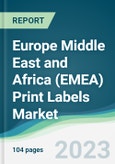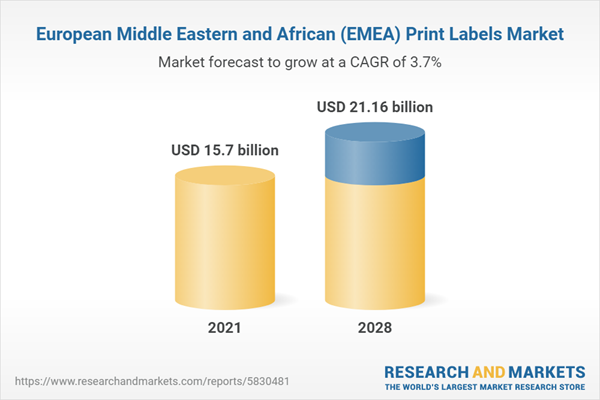The Europe, Middle East and Africa (EMEA) print labels are projected to grow at a CAGR of 3.73% over the forecast period, increasing from US$15.704 billion in 2021 to US$21.155 billion by 2028.
Print labels provide information about the product to potential consumers via a label on the package or container. It is a brand marketing strategy businesses use to set their goods apart from their rivals. Numerous regulatory bodies from various sectors have established regulations for the information that must be disclosed to consumers on product labels. For instance, food items must reveal the production and expiration dates, and electrical equipment must publish usage instructions. According to Label Insight and the Food Marketing Institute, 86% of consumers are concerned about transparency when grocery shopping. They would place more faith in food producers and merchants that give comprehensive, simple-to-understand ingredient information.A strong presence of established printing industries and advanced manufacturing capabilities characterizes the European print label market. The countries in the region boast a large consumer base, technological advancements, and a high demand for printed labels across various sectors, including food and beverage, pharmaceuticals, logistics, and retail.
With increasing environmental awareness and regulations, there is a growing demand for eco-friendly and recyclable labels.
European consumers and businesses prioritize labels made from sustainable materials and utilize solutions that minimize waste and reduce carbon footprints. This trend drives innovation in eco-friendly label materials, printing techniques, and recycling processes. Europe has stringent regulations regarding product labeling, safety information, and traceability. Label manufacturers must adhere to labeling standards, including EU regulations and industry-specific requirements. Compliance with regulations such as REACH (Registration, Evaluation, Authorization, and Restriction of Chemicals) and GHS (Globally Harmonized System of Classification and Labelling of Chemicals) is crucial for label manufacturers to operate in the European market.The brisk growth of the food and beverage (F&B) sector and the rising use of print labels in the food industry is boosting the market growth.
For instance, in September 2022, the European Union passed a mandate to include various essential label information. This information should be accurate, easy to see and understand, not misleading, and inedible. In addition, the widespread use of print labels in various applications, rising consumer health consciousness, and rising demand for manufactured goods are contributing to the market's expansion.The pressure-sensitive labels is the key segment of the EMEA print labels market.
Pressure-sensitive labels made from biomaterials are anticipated to be used more often, offering the market a significant chance for expansion. Packaging is expected to dominate the pressure-sensitive market throughout the forecast period among end-user industries.According to UN Environment, only 9% of plastic gets recycled, with the remaining ending up in landfills, dumping grounds, and the environment. Label recycling is governed by rules and regulations put in place by governments. For instance, the UK government and the Devolved Administrations expressed a strong desire to establish extended producer responsibility for the packaging, requiring producers to pay the full cost of disposing of the waste they produce. To curb this issue, key players in Europe Middle East, and Africa are focusing on launching new products due to the growing use of pressure-sensitive labels in the packaging industry and producers switching to more biodegradable methods. For instance, in May 2022, Mondi moved to approved base paper for all glassine-based release liners, which are mainly used in labels. It is enhancing traceability by switching to certified base paper and collaborating with suppliers who responsibly manage forests in keeping with its objective of preserving zero deforestation across its supply chain.
Market Developments:
- In May 2023, the upgrade of Mondi's Dynäs pulp and paper factory in Sweden was announced. The mill is well-positioned to continue satisfying customer demand for sustainable paper and paper-based packaging solutions utilized in pressure-sensitive labels due to the modernization program's increased efficiency and overall improvement of the mill's environmental performance.
- In April 2022, a prominent supplier of pressure sensitive and shrink sleeve prime labels, Brook + Whittle, disclosed that it had signed a binding contract to buy the Custom Labels Group from Cenveo Worldwide Limited ("Cenveo").
- In January 2021, the acquisition of Clinical Systems, Inc. ("CSI"), a specialized supplier to the US clinical trials industry, was announced by CCL Industries Inc., a global leader in specialty label, security, and packaging solutions for multinational corporations, governmental institutions, small businesses, and consumers.
- In January 2021, Avery Dennison, one of the well-known label manufacturing businesses in Europe, acquired ACPO, a company headquartered in the United States, in a deal for $87.6 million. The agreement assists the business in further solidifying its position in key label materials.
Market Segmentation:
BY TYPE
- Pressure Sensitive Labels
- In-Mold Labels
- Wet-Glued Labels
- Sleeve Labels
- Multi-Part Tracking Labels
- Others
BY PRINTING TECHNOLOGY
- Flexography
- Offset
- Screen
- Letterpress
- Gravure
- Digital
BY END-USER INDUSTRY
- Healthcare
- Food and Beverage
- Personal Care
- Industrial
- Household Care
- Consumer Electronics
- Others
BY COUNTRY
- Germany
- France
- United Kingdom
- Others
Table of Contents
Companies Mentioned
- Mondi
- Cenveo
- CCL Industries
- Bemis
- 3M
Methodology

LOADING...
Table Information
| Report Attribute | Details |
|---|---|
| No. of Pages | 104 |
| Published | June 2023 |
| Forecast Period | 2021 - 2028 |
| Estimated Market Value ( USD | $ 15.7 billion |
| Forecasted Market Value ( USD | $ 21.16 billion |
| Compound Annual Growth Rate | 3.7% |
| Regions Covered | Africa, Europe, Middle East |
| No. of Companies Mentioned | 5 |









